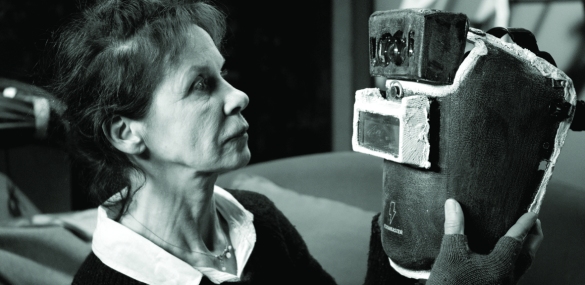Luciana Dumitru: NOT EYE drew my attention in two directions: looking (and being looked upon) and the gaze in cinema. Some philosophers think of identity as fragmented, non-unitary, non-essentialist, unfixed. In looking and being looked upon, there is an undoing of each other, in a certain sense. You’ve said the character has a problem finding her own identity,“she sees it fragmented” because of the others’ look. Can you say a few words about the relation between the other’s look and the fragmented identity?
LAUREN MOFFATT: The relationship between the camera and the eye is important to the story and the way the main character understands her world. We see photographic images of ourselves from a very early age and I think it teaches us to see ourselves in our own mind’s eye. We become aware of how we might be seen from a particular person standing at a particular angle. Using these snapshots we can construct a mental image of the self, which we can then use as a guide for evaluating and controlling how we appear and behave in certain situations. When we are surrounded by people, and each person is seeing us from a different perspective, then the shape of that mental image could begin to warp and scatter. In that scenario we lose the clear, synthesized image and in its place find a lot of pieces that don’t match up, and that is how the woman in the film feels.
Luciana Dumitru: Looking is relational and multiple. An example for the complexity of looking is Marina Abramović´s “The Artist is Present”. Why did you choose to talk about the aggression of being looked upon in relation to others, that your character feels, which seems easier to understand when she talks about being observed by video cameras. Does it have something to do with your character being a woman? Or merely with the feeling of being under surveillance, “turned into a picture” ?
LAUREN MOFFATT: When this character speaks about aggression she is referring to the feeling of being watched and existing against her will as an image. I think one of the reasons some people are uncomfortable having their photo taken or being filmed is that when someone looks at a photographic image of a person, that person has no control over how that happens.When you are faced with another person in real life there is certain etiquette about where the other is allowed to look, for how long and so on. On the other hand we are allowed to stare at photos however we’d like to, and that’s what they’re made for. There is something creepy about that.
Luciana Dumitru: The discussion moves to the gaze in cinema, where the relationship of looking is more or less exploitative. In the case of the male gaze women (on screen) are fetishized, objectified for the (male) pleasure of looking. In the case of racial representation, white/Western gaze touches on other critical sensibilities and so on. Yet there are ways and strategies to overturn the power relation in filming and also in watching the film. An example that comes to mind is Chantal Akerman´s “La Chambre”, where she has a special relation to the camera and she gazes back and confronts the viewer. The film reminded me of Sembene Ousmane´s film, “Black Girl”, where, at the end, the black child looking at the viewer covers his face with a mask, as he pursues the white man. In your film, not only that I am looked upon, but I am also aware of the danger of being filmed, being under surveillance, without being able to read beyond the filming mask/helmet. Can you talk a little bit about this way of looking back and what do you expect the spectators to experience?
LAUREN MOFFATT: This defiance of meeting the eyes of an oppressive person or thing is central to the shift that happens around two thirds of the way through the film. Because of the role the camera plays as the conductor of plot in cinema, whoever is holding it essentially has the power. At this moment in NOT EYE there is a reordering of the hierarchy and the invisible aspects of the situation are revealed to us and therefore made vulnerable.
I’m not sure what I expect spectators to experience watching this shift take place. When I watch it I find it unsettling, satisfying and slightly amusing.
Luciana Dumitru: Is the director’s gaze so powerful, as Laura Mulvey claims with regard to narrative cinema? Or do you think women may have a gaze of their own in watching the film, as Bell Hooks states in her theorizing about the oppositional gaze?
LAUREN MOFFATT: This is a difficult question. When I wrote the screenplay, the different viewpoints of the two recording systems (the mask and the 3D rig) and the people manipulating them were less about gender than about the gaze of an individual faced with an institutionalized, collective gaze. But it is possible to see how it could be understood as a power framework, with the ruling majority dominating the isolated minority subject. It would be interesting to recast the main character as a man and her interviewer as a woman and see how that would change the way the film is read. At the end of the day, it was myself as director who was controlling both of the systems in play. I was wearing the mask in the subway and I was controlling the image making on the set. Therefore both of the gazes are technically those of a woman, and while the majority of the cinematic influences that contributed to the way I understand filmmaking were male I still think that the fact that I was able to make this film is in itself an oppositional gaze if we are talking about how women have advanced over the past century.
Luciana Dumitru: Why did you choose filming in black and white? And why stereoscopic 3D?
LAUREN MOFFATT: I chose black and white because I wanted to make a universe that would be minimal and visually seductive at the same time, so the opportunity to exaggerate form and texture made sense. It was also the first stereoscopic 3D film I have ever made, so reducing the number of parameters I needed to manipulate allowed me to concentrate more closely on the 3D storytelling. With the color information taken out of the equation, the spatial relationships become simpler and more striking. I think it is also beneficial for the construct as a whole because it makes the film more immediately legible as a work of photography and not an attempt at reconstructing reality.
As for the 3D aspect, the film was a stereoscopic project from the beginning, mostly because I thought the references to the human gaze required a binocular camera playing alongside the characters, but also because I wanted to put the spectator directly within the different gazes. Glasses-based 3D viewing systems essentially allow you to project the images almost directly onto the retina. It is very intimate and quite invasive in a way. These sorts of paradoxes played a big role in the development of the script, and especially the main character.
Luciana Dumitru: I like very much the spectral image in the subway. I can see the subway tracks, but also the others reflected in the window, that somehow look back at me, just as the camera does. Did you have any particular reason for filming these images in the underground?
LAUREN MOFFATT: The subway passage is an essential part of the film. It is a moment where the shot and the reverse shot from the first two thirds of the story fuse into one image. The experience of standing at the front window of a driverless train is in itself quite hypnotic for me, and because I was spending a lot of time on the subway when I was developing the project it eventually just clicked that it could be even more powerful as a mediated image. This is especially true in 3D, because the two worlds are superimposed in quite an eerie way. When you are actually riding in the subway you are aware of what’s going on with the reflection but in a film-viewing situation it transports you into a ghost train.
Luciana Dumitru: What artists inspire you? And why?
LAUREN MOFFATT: Clemens von Wedemeyer and Samuel Beckett were both important when I was working on NOT EYE. Both artists have made works using the subjective camera in a meaningful way and I spent a lot of time thinking about “From the Other Side” and “Film” before I arrived at a place where I was ready to make this work.
Luciana Dumitru: What interests you the most at the moment?
LAUREN MOFFATT: At the moment I am still very interested in visual perception, but I am focused on the way we learn to see and how our impressions are based on memory. I am becoming more interested in the projection side of the visual system rather than the reception side, which I think was explored in NOT EYE.

